Going the Distance. Epic Migrations.
“It always seems impossible until it’s done.” — Nelson Mandela.
I moved a lot in my childhood all over the United States. Coast to coast, north and south, east and west. Some of the moves were over vast distances but nothing like bird migrations that span the globe. Over oceans and mountain ranges, rivers and deserts, birds follow their ancient instincts to find food and nesting, traveling from areas of low or decreasing resources to areas of high or increasing resources.
Let’s meet some of the champions:
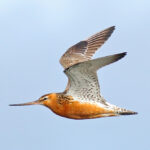 Bar-tailed Godwit (Limosa lapponica)
Bar-tailed Godwit (Limosa lapponica)
This bird has unmatched stamina. They fly nine days without sleep, food or water. The Bar-tailed Godwit holds the record for the longest non-stop flight of any bird flying over 6,800 miles without resting. They have a very large range but many of the subspecies are struggling, particularly the Godwits that fly the East Asian-Australasian route which is experiencing rapid declines mostly due to habitat loss.
Endangered status: Least concern.
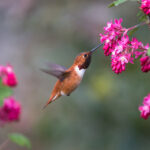 Rufous Hummingbird Selasphorus rufus
Rufous Hummingbird Selasphorus rufus
Punching above its weight at .12 ounces, this tiny bird is a true warrior. The Rufous Hummingbird travels over 3,000 miles on its migration from nesting sites in Oregon, Idaho and British Columbia to wintering grounds in Mexico. With their enhances spatial memory this bird can remember feeder locations from prior years in their home territories as well as along their migratory path. Like all hummingbirds they need alot of fuel and must feed continuously, visiting over 1,000 flowers per day. They also need lots of protein which they get from tiny insects that they capture in the air as well as on foliage and flowers.
Endangered status: Near threatened
 Short-tailed Shearwater (Ardenna tenuirostris)
Short-tailed Shearwater (Ardenna tenuirostris)
This talented flyer travels from its breeding grounds in Tasmania and southern Australia to the far east coast of Russia, then continue on to the Aleutian Islands in Alaska, the circle back around the Pacific Ocean and travel back along the western coast of North America. They can fly for extended periods of time as their bodies are perfectly adapted for gliding above the water thus saving energy. Even more remarkable is the fact that after travelling such vast distances, they return to the same burrow every year!
Endangered status: Population declines in some areas.
 Bar-headed Goose (Anser indicus)
Bar-headed Goose (Anser indicus)
This hardy bird’s migration is between 1,800 and 3,100 miles. They fly from their breeding grounds in Mongolia and northern China to their wintering sites in India. They traverse the Himalayan mountains, reaching altitudes of up to 4.3 miles while using 10% of the oxygen available at sea level. Despite reliable tail winds that blow up the Himalayas, Bar-headed geese refuse these winds, waiting for nighttime when they die down, then undertaking the greatest rates of climbing flight ever recorded for a bird. They can sustain these climbs rates for hours on end.
Endangered status: Least concern.
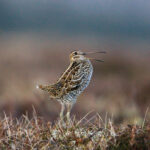 Great Snipe (Gallinago media)
Great Snipe (Gallinago media)
Travelling over 4,225 miles, this bird is a real marathon flyer. Even without tailwinds they can reach speeds of up to 60 mph flying from Scandinavia to sub-Saharan Africa. They fly nonstop, losing half their body weight from the migration. Some have been recorded flying non-stop for 84 hours. This small, beautifully camouflaged wading bird inhabits grasslands, marshes, wet meadows and grassy bogs. When on their wintering grounds they are often be found in rice fields and recently flooded areas.
Endangered status: Near Threatened.
 Adélie Penguin (Pygoscelis adeliae)
Adélie Penguin (Pygoscelis adeliae)
Sometimes a bird’s migration is not a soaring affair. The Adélie Penguin undertakes a grueling march of about 8,000 miles every year from their breeding ground to their winter grounds in the Ross Sea area of Antarctica and back. The biggest challenge is they need access to the sea to feed. The solution is to keep walking to the edge of the ice, which is expanding during the winter months and then in the spring, they stay remain close to the edge while the ice recedes.
Endangered status: Populations increasing.
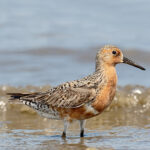 Red Knot (Calidris canutus)
Red Knot (Calidris canutus)
This small bird with a wingspan of 20” flies nearly 9,300 miles on its migratory journey. They travel from the southern coasts of Chile and Argentina to the Canadian Artic. This epic migration is now threatened by humans due to coastal development and overharvesting of horseshoe crabs, whose eggs are a critical source of food. They are also fond of mollusks which they swallow whole and crush the shells up in the muscular part of their stomach, known as the gizzard.
Endangered status: Threatened
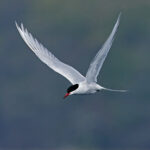 Arctic Tern (Sterna paradisaea)
Arctic Tern (Sterna paradisaea)
This tern holds the record for the longest migration known in the entire animal kingdom. Flying 55,923 miles from pole to pole every year! Their migration goes from Greenland in the North to the Weddell Sea in the South. Arctic Terns can live up to 30 years so if we do the math, their lifetime journal can be the equivalent of going to the moon and back more than three times. The Arctic tern nests once every one to three years depending on the mating cycle. They mainly eat fish and small marine invertebrates.
Endangered status: Least concern, population decreasing.
The next time you hear a comedian use the old joke “I just flew into town… boy are my arms tired.” Think how tired these intrepid travelers must be!
Ross A. Feldner, RCC Board Member
 Ross Feldner is the lead, with Bob Musil, of the RCC Bird Watch and Wonder Program. Ross is a life-long birder and photographer who is the editor of the Friends of Patuxent National Wildlife Refuge newsletter. Ross also serves as a guide at the Patuxent National Wildlife Refuge, a frequent birding spot for Rachel Carson who first learned about the health effects of DDT at the laboratory there. He is also the owner/art director of New Age Graphics, a full-service graphic design firm in Wheaton, MD.
Ross Feldner is the lead, with Bob Musil, of the RCC Bird Watch and Wonder Program. Ross is a life-long birder and photographer who is the editor of the Friends of Patuxent National Wildlife Refuge newsletter. Ross also serves as a guide at the Patuxent National Wildlife Refuge, a frequent birding spot for Rachel Carson who first learned about the health effects of DDT at the laboratory there. He is also the owner/art director of New Age Graphics, a full-service graphic design firm in Wheaton, MD.
![]() The Rachel Carson Council depends on tax-deductible gifts from concerned individuals like you. Please help if you can.
The Rachel Carson Council depends on tax-deductible gifts from concerned individuals like you. Please help if you can.
![]() Sign up here to receive the RCC E-News and other RCC newsletters, information and alerts.
Sign up here to receive the RCC E-News and other RCC newsletters, information and alerts.






